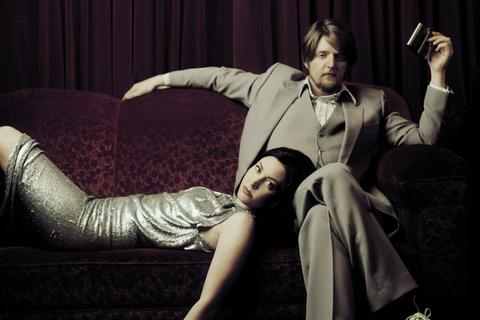The Audreys
Listen to Oh Honey
To label The Audreys as just another roots-folk band would be a tragic mistake.
Taasha Coates should have been a nightclub singer, crooning like Lena Horne before a starstudded crowd at the Cocoanut Grove in 1950s Los Angeles. Tristan Goodall, on the other hand, would probably choose to be reborn as a member of Crazy Horse rocking out Everybody Knows This Is Nowhere in 1969. (I once sent Taasha a Tom Petty compilation, knowing how much she detested Petty’s music. Tristan got the CD stuck in Taasha’s car stereo, where it tortured her for months. Tristan, on theother hand, couldn’t have been happier.)
The Audreys is the common ground where these two extremes collide and, extraordinarily, coalesce. It’s all there on the front cover of their debut record, Between Last Night And Us – the glamorous frock and gloves holding a delicate bird on one side; the crumpled suit and masculine hands offering a bird’s nest on the other. Prophetic symbolism.
To me, The Audreys has always been about the tension and beauty resulting from the union of extremes; the masculine and the feminine; the yin and the yang; the light and the dark; the classic and the modern. That tension is palpable every time the band takes to the stage, where I often get the feeling that Taasha and Tristan each have some wild secret they’re longing to publicly confess. Somehow each tempers the other for a greater cause – the music.
“I’ve gone a little bit country since I met you baby. I used to be so rock ‘n’ roll,” Taasha sings in one of the band’s earliest and most defining hits, ‘Banjo & Violin’. The song traces the genesis of The Audreys to a day in country Victoria back in 2003. Holed up in a winery (where else?) in wild weather, Taasha and Tristan joined a group of bluegrass players huddled around an open fire. As strings were plucked and caressed and harmonies soared, their long-suppressed love of old school country music suddenly seemed no longer anything to be ashamed of. Indeed, it provided a platform on which Taasha and Tristan could truly see eye to eye. “Blame it on the banjo and violin.”
Their musical partnership has endured plenty over the last ten years – countless miles on the road cooped up in vans; hundreds of shows (from tiny dives to the world’s biggest festivals); a series of immeasurably talented band members; crippling writer’s block; relocations between Melbourne and Adelaide; three albums, each of which won an ARIA Award for Best Blues & Roots Album (which has to be some kind of record!)
As if all this were not enough, Taasha and Tristan were once a couple. That their musical relationship has survived – and, indeed, thrived – in the face of their breakup and subsequent individual romances is possibly the ultimate testament to its strength. Presented with the opportunity to go back and journey through The Audreys’ collected recordings, I find it remarkable how fully realised the band’s founding blueprint was from the very beginning. Take ‘You & Steve McQueen’ or ‘Oh Honey’ as shining examples. It’s all there – the banjos and violins, the subtle rumbling rhythms, and the vocal melodies and harmonies floating above all with consummate grace, the romance and tragedy.
The Audreys have remained true to that founding sound over the past ten years and three albums, a sound that has been augmented by a number of invaluable contributors. I don’t think either Tristan or Taasha would deny the significance of the role that Shane O’Mara has played in fostering that sound as producer and engineer of all three records. Which isn’t to say The Audreys’ music has not evolved. Although Taasha announced, “There’s a big change coming,” in the opening lines of the band’s second album, When The Flood Comes, each consecutive album has been an exercise in refinement rather than revolution.
Interestingly, both When The Flood Comes (2008) and Sometimes The Stars (2010) were born from adversity. The former lived up to the “difficult second album” tag, with Tristan and Taasha finding themselves exhausted after touring the first album. It took a jaunt to New York’s infamous Chelsea Hotel to reignite the creative spark and produce the album’s ominous opener ‘Chelsea Blues’. When The Flood Comes simmered with a lyrical and musical eloquence that prompted me to observe at the time, “This is not the frivolous young rootsy pop band that I’m sure many hoped The Audreys would become.”
When it came to facing album number three, Tristan and Taasha found themselves without a band. After touring When The Flood Comes, everyone went their separate ways, unsure if there would even be an Audreys to return to. With Shane O’Mara’s guidance, the duo hand-picked musicians to suit each new composition for Sometimes The Stars. This resulted in easily the band’s most interesting and genre-defying work to date, producing some spectacular surprises like the barrel house blues of ‘Poorhouse’ featuring a tooth rattling piano performance by Paul Grabowsky.
Where to next for The Audreys? You’d have to ask Tristan and Taasha that, and even then you’d probably get a different answer on any given day. You can bet that neither of them expected to enjoy a triumphant ten- year career out of a little Adelaide band that formed over a love of banjos and violins.
- MARTIN JONES, MANAGING EDITOR, RHYTHMS MAGAZINE. APRIL 2012.



